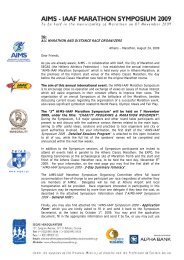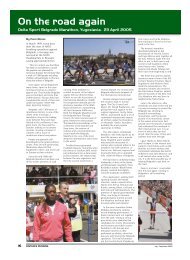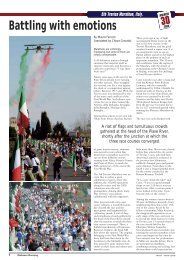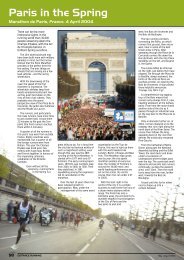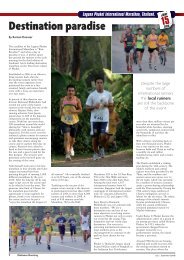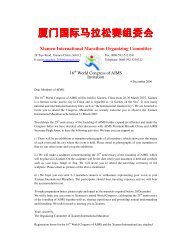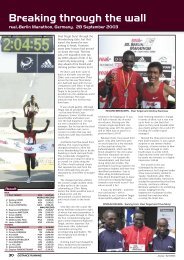Children and Marathoning Final Version 11.02 - AIMS
Children and Marathoning Final Version 11.02 - AIMS
Children and Marathoning Final Version 11.02 - AIMS
Create successful ePaper yourself
Turn your PDF publications into a flip-book with our unique Google optimized e-Paper software.
Risk factors unique to the growing child are numerous. It is well known that<br />
stress fractures, a distinct overuse injury, are a function of the number of repetitions <strong>and</strong><br />
amount of applied force per repetition (17). Clearly, a child with shorter stride length<br />
subjects himself to more repetitions of impact to cover the same distance as an adult.<br />
Immature articular cartilage is more susceptible to shear force than adult cartilage <strong>and</strong><br />
predisposes children to osteochondritis dissecans (20, 21). It has also been shown in<br />
studies by Stulber <strong>and</strong> Harris that injuries to the growth plate from repetitive trauma are<br />
possible etiologic factors in adult onset arthritis of the hip (20, 22, 23). <strong>Children</strong> are also<br />
prone to injury at apophyses such as the tibial tubercle, resulting in Osgood-Schlatter<br />
disease, <strong>and</strong> the calcaneus, resulting in Sever's disease (20, 24). A final characteristic of<br />
children that predisposes them to overuse injury is the asynchrony of bone growth <strong>and</strong><br />
muscle-tendon elongation. During periods of rapid growth, bone growth occurs first with<br />
delayed muscle tendon elongation <strong>and</strong> resultant decreased flexibility (20, 25).<br />
For the safety of young runners, it is imperative that the training program <strong>and</strong> its<br />
progression be followed closely <strong>and</strong> monitored carefully. From injury surveillance data<br />
conducted on high school athletes in Seattle over a fifteen year period, the activity with<br />
the highest rate of injuries was girls cross-country; this injury rate was statistically<br />
significantly higher than the other known "high risk sports" of football, wrestling <strong>and</strong><br />
gymnastics (26, 27, 28, 29). Boys cross-country also had a surprisingly high rate of<br />
injuries, placing fifth overall (behind girls cross-country, football, wrestling <strong>and</strong> girls<br />
soccer). Distance running among adolescent boys <strong>and</strong> girls is thus associated with a<br />
relatively high rate of injury. For these athletes, the competitive distance is no more than<br />
3 miles (27, 28, 29). Thus, training to run in a marathon, which is more than eight times<br />
6




